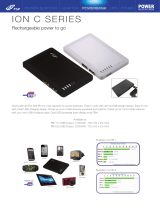
RabbitCore RCM4300/RCM4310/RCM4320 User’s Manual 4
4.4 A/D Converter (RCM4300 only)........................................................................................................41
4.4.1 A/D Converter Power Supply .....................................................................................................43
4.5 Other Hardware...................................................................................................................................44
4.5.1 Clock Doubler .............................................................................................................................44
4.5.2 Spectrum Spreader ......................................................................................................................44
4.6 Memory...............................................................................................................................................45
4.6.1 SRAM .........................................................................................................................................45
4.6.2 Flash Memory .............................................................................................................................45
4.6.3 VBAT RAM Memory.................................................................................................................45
4.6.4 microSD Cards............................................................................................................................45
Chapter 5. Software Reference 47
5.1 More About Dynamic C .....................................................................................................................47
5.2 Dynamic C Function Calls.................................................................................................................49
5.2.1 Digital I/O ...................................................................................................................................49
5.2.2 Serial Communication Drivers....................................................................................................49
5.2.3 Serial Flash Memory Use............................................................................................................50
5.2.4 User Block...................................................................................................................................52
5.2.5 SRAM Use ..................................................................................................................................52
5.2.6 RCM4300 Cloning......................................................................................................................53
5.2.7 microSD Card Drivers ................................................................................................................53
5.2.8 Prototyping Board Function Calls...............................................................................................54
5.2.8.1 Board Initialization............................................................................................................. 54
5.2.8.2 Alerts .................................................................................................................................. 55
5.2.9 Analog Inputs (RCM4300 only) .................................................................................................56
5.3 Upgrading Dynamic C ........................................................................................................................73
5.3.1 Add-On Modules.........................................................................................................................73
Chapter 6. Using the TCP/IP Features 74
6.1 TCP/IP Connections ...........................................................................................................................74
6.2 TCP/IP Primer on IP Addresses..........................................................................................................76
6.2.1 IP Addresses Explained ..............................................................................................................78
6.2.2 How IP Addresses are Used........................................................................................................79
6.2.3 Dynamically Assigned Internet Addresses .................................................................................80
6.3 Placing Your Device on the Network .................................................................................................81
6.4 Running TCP/IP Sample Programs ....................................................................................................82
6.4.1 How to Set IP Addresses in the Sample Programs .....................................................................83
6.4.2 How to Set Up your Computer for Direct Connect ....................................................................84
6.5 Run the PINGME.C Sample Program ................................................................................................85
6.6 Running Additional Sample Programs With Direct Connect.............................................................85
6.7 Where Do I Go From Here? ...............................................................................................................86
Appendix A. RCM4300 Specifications 87
A.1 Electrical and Mechanical Characteristics .........................................................................................88
A.1.1 A/D Converter............................................................................................................................92
A.1.2 Headers.......................................................................................................................................93
A.2 Rabbit 4000 DC Characteristics.........................................................................................................94
A.3 I/O Buffer Sourcing and Sinking Limit .............................................................................................95
A.4 Bus Loading .......................................................................................................................................95
A.5 Jumper Configurations.......................................................................................................................98
A.6 Conformal Coating...........................................................................................................................100
Appendix B. Prototyping Board 101
B.1 Introduction ......................................................................................................................................102
B.1.1 Prototyping Board Features......................................................................................................103
B.2 Mechanical Dimensions and Layout................................................................................................105
B.3 Power Supply ...................................................................................................................................106





















